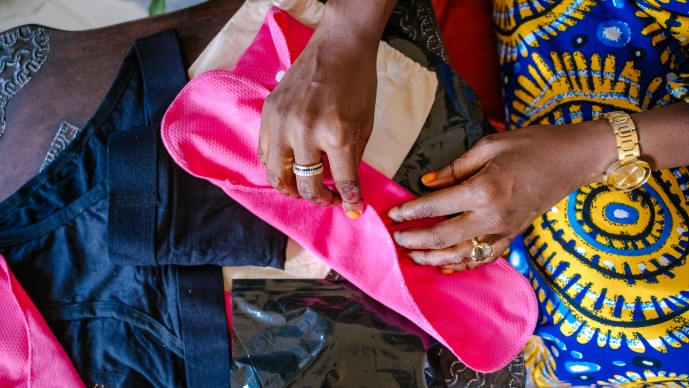Accelerating Innovations to Address Heavy Menstrual Bleeding in Women in Low-Resource Settings

Please note: We anticipate notifying applicants of decisions related to this RFP by the end of June 2025. This timeline is later than originally stated in the Rules and Guidelines document.
Before applying, applicants should familiarize themselves with the supporting documents for this Grand Challenge, including the terms and conditions of the Gates Foundation, the Rules and Guidelines, Application Instructions, and Frequently Asked Questions.
If you are planning to apply to this RFP, we will be hosting a dedicated webinar on February 25, from 7:00 to 8:00 AM Pacific Time. This session will provide a comprehensive overview of the RFP details and an opportunity to have your questions answered. To participate in the webinar, please register and submit your questions in advance. If you cannot attend live, the webinar will be recorded and available on this challenge page after the session.
Background
Heavy menstrual bleeding (HMB) affects millions of women globally. Clinically, HMB is defined as excessive menstrual blood loss that negatively affects a woman's physical, emotional, and social well-being. In research settings, HMB is defined as directly measured blood loss exceeding 80 milliliters per menstrual cycle. Many women seek medical attention based on their perceptions of heavy bleeding and its impact on daily life. Abnormal uterine bleeding, of which HMB is a subset, is caused by various factors. Structural abnormalities include polyps, adenomyosis, fibroids, and malignancy, while non-structural factors include bleeding disorders, ovulatory and endometrial dysfunction, and other factors.
Managing HMB presents significant clinical challenges when diagnostic tools are unavailable or inaccessible to distinguish between the diverse possible etiologies. The underlying biological mechanisms, particularly related to endometrial dysfunction-related HMB also remain poorly understood. For an individual woman, the preferred medical and surgical treatment options depend on the specific cause, symptoms, preferences (including factors such as pregnancy intention), and the availability of treatment, including minimally invasive therapies. Currently available medical treatments include hormonal therapies, including contraceptives, such as the hormonal intrauterine device, and non-hormonal options, such as tranexamic acid and non-steroidal anti-inflammatory drugs (NSAIDs). The efficacy of treatment could be improved with an increased understanding of the underlying biological mechanisms and the development of specifically targeted therapies.
Research priorities in HMB include understanding the underlying biological mechanisms, particularly related to endometrial dysfunction-related HMB, developing and introducing cost-effective and easy to scale-up diagnostics to identify causes of HMB and guide treatment, and identifying ways to increase acceptability and access to treatments such as the hormonal intrauterine device for women in low-resource settings.
The Challenge
We invite research proposals on HMB based on the clinical definition that focus on:
- Biological Mechanisms – Advancing understanding of the fundamental biology of HMB to identify targets for innovative diagnostics and treatments.
- Epidemiology and Impact – Assessing disease burden, patterns, and impact on gynecological health and quality of life in women in low-resource settings.
- Measurement and Standardization – Developing and validating improved methods for measuring HMB and establishing standardized research protocols to enable consistent and comparable studies across diverse populations and healthcare systems.
- Innovative Diagnostics – Proposing new technology or piloting the use of existing technology to identify causes of HMB in low resource settings, including the use of artificial intelligence. Technology should be easy to use and affordable.
- Treatment and Access – Evaluating the effectiveness, acceptability, and ways to increase access to treatment including hormonal contraceptives, to inform patient-centered care in low-resource settings.
Funding Level
We will consider proposals for awards of up to 150,000 USD for each project, with a grant term of up to 2 years. Application budgets should be commensurate with the scope of work proposed. Indirect costs will be considered and should be included in the budget for a maximum of 15% of the total award (subject to the Gates Foundation's indirect cost policy).
Eligibility Criteria
This initiative is open to nonprofit organizations, for-profit companies, international organizations, government agencies and academic institutions. We particularly encourage applications involving projects led by women or from women-led organizations and applications from institutions based in low- and middle-income countries.
We seek proposals that:
- Focus on original research and development.
- Focus on the needs of women in Sub-Saharan Africa, India, and Pakistan. While researchers may be based globally, study populations (for original data collection) or intended beneficiaries (for new diagnostics and treatments) must be from these regions.
- Address one or more of the outlined objectives within a single proposal.
We will not fund proposals that:
- Do not focus on HMB – Even if related to gynecological conditions that are associated with HMB, such as infertility or pelvic pain.
- Are not research. Proposals to fund the expansion of routine services, or train clinical service providers, for example, will not be funded.